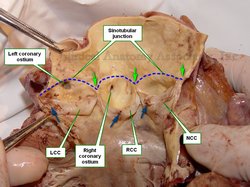The sinotubular junction (STJ) is a well-defined circular ridge found between the superior or tubular segment of the ascending aorta and the inferior, bulbous segment of the ascending aorta, known as the aortic root.
The STJ follows the superior contour of the three sinuses of Valsalva that form the bulbs of the aortic root and intersects the commissures of the aortic valve. In the accompanying image the STJ is depicted by a blue dotted line and the commissures are depicted by green arrows.
The ostia of the coronary arteries are usually found inferior to the STJ, although they can be on it or superior to the STJ. There seems to be a correlation with anomalous origins of the coronary ostia and sudden-death syndrome.
The image also shows the three cusps of the aortic valve: the non-coronary cusp (NCC), the right coronary cusp (RCC) and the left coronary cusp (LCC). The blue arrows indicate the location of the nodules of Arantius.
Medical terminology notes: There are many scholarly texts that hyphenate the word as [sino-tubular]. This is incorrect, as the root term is [-sin-], meaning "sinus". The addition of the [-o-] to the root term creates the combining form [-sino-] which is then used to connect to the root term [-tubul-]. Since it is a vowel and a consonant combining and they are euphonic, there is no need to add the hyphen. In fact, a word should use as a combining element either a hyphen or an [-o-], but not both. The word with the hyphen then should be [sin-tubular] which is definitely not euphonic. For more information on combining root terms, click here.
Others write [sinutubular]. The paragraph above clearly explains why this is a mistake. The root term is [-sin-] meaning "sinus" and the addition of the [-o-] creates the combining form [-sino-] and not [-sinu-].
Sources:
1. “Clinical Anatomy of the Aortic Root” Anderson, RH Heart 200; 84: 670–673
2. “The Anatomy of the Aortic Root” Loukas, E et al. Clin Anat 2014; 27:748-756
3: "Tratado de Anatomia Humana" Testut et Latarjet 8th Ed. 1931 Salvat Editores, Spain
Image property of: CAA.Inc.Photographer: D.M. Klein




